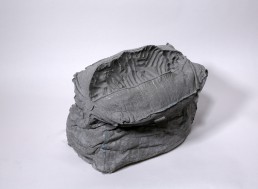Gallery Himmelblau| Tampere | 2023
Symbioses and paradoxes
Kaisaleena Halinen’s exhibition is spread across two spaces at the Himmelblau Gallery. The works in the old cotton hall draw inspiration from the history of the Finlayson mill. The hall is filled with a soundscape created in collaboration with Jani-Matti Salo that is based on a recording made onsite at the mill by the Finnish Broadcasting Company in 1990. In its day, the mill was its own miniature community that exerted a powerful formative influence on the identity of its members. The mill provided work and income, but the workers in turn endured heavy labour, long hours, and exposure to deafening industrial noise.
If the factory left an indelible mark on the workers, so too did they leave traces of their presence visible in the mill’s structures. The artist lyrically accentuates these human traces in her window grills made of human hair fibres that she has spun and carded the traditional way. The same methods were once used at the mill, albeit in mechanized form. The hair-woven window grills embody the symbiotic relationship between the mill and its workers.
Halinen is intrigued not only by symbioses, but also by paradoxes. The questions she raises in the old cotton hall are reprised in the exhibits in the main gallery. Her blurring of the line between the logical and illogical comes to light strikingly in Concrete Drum. A concrete drum cannot resonate sound, and it would be futile to strike it with glass drumsticks. Such paradoxes can visualize the thorny complexities of our reality. There are no easy answers, and going to extremes only undermines the force of one’s message.
The most engaging feature of Halinen’s art is its nuanced power of suggestion. Her ambiguous pillar pieces for instance evoke associations with human civilization and society’s support structures, but their organic allusions expand the horizon of interpretation in a different direction, invoking the vulnerability of nature. Through subtle symbioses and the marriage of seemingly incompatible elements, Halinen activates the viewer’s own memory webs, thus offering a reflective surface that mirrors our surrounding reality. Halinen eschews facile generalizations and spurious either-or logic of the kind that too often brings social debate to a grinding halt.
Tomi Moisio, PhD, art historian













